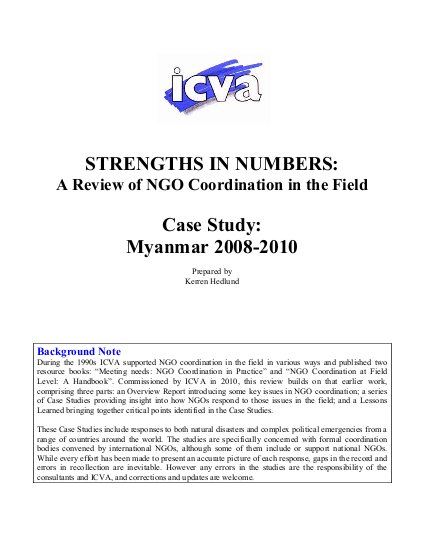
On the night of 2 May 2008, a category 5 cyclone struck the delta of Myanmar; a vast and treeless paddy land with a high population density. The country and the humanitarian community were unprepared although news of the cyclone had been available for a week. Exacerbating delays, the Myanmar government prohibited immediate access to the affected area. However within days a few international agencies were providing aid to communities while literally thousands of local groups and individuals distributed essential relief; particularly the Myanmar Red Cross with the International Federation of Red Cross Societies and local religious networks. There were no facilities large enough to immediately accommodate the need for coordination and information sharing, only fledgling systems in place for information collection, analysis and distribution and a dormant cluster system with no experienced cluster leads. As OCHA was not officially active in country, there was only one staff member with „consultant? status. There was an active in-country Inter-Agency Standing Committee (IASC) - an inclusive meeting convened by the Humanitarian Coordinator (HC). There was an interim HC with little experience of rapid onset emergencies but on very good terms with the humanitarian community and on relatively good terms with the government. The Paung Ku INGO Consortium1 the year before (after the „Saffron Revolution?) had motivated the INGO community to make their first joint advocacy statement on the deteriorating humanitarian situation.2 This was followed by the establishment a separate INGO Forum to continue and support candid discussions on the humanitarian situation in the country and decide on individual and joint advocacy initiatives. 3 As of January 2008 the INGO Forum had a facilitator for 3 days a month to prepare and facilitate monthly discussions. The local NGO community was largely underground due to government restrictions on civil society organisations. Approximately 40 INGOs were directly providing services in education, health and food aid in discrete areas in the country. Few had partnership approaches to either development or humanitarian relief (4 out of 40). Only 5 INGOs and one large local NGO (LNGO) had existing but very small operations in the affected area. Over 50 new INGOs were arriving on the scene with little or no knowledge of operating conditions, procedures and restrictions. Existing INGOs were seriously overstretched to deal with the magnitude of the disaster and were inhibited to scale up due to visa restrictions in the first 2 months. The majority of LNGOs were implementing spontaneous responses with little to no knowledge of humanitarian principles, codes of conduct and other tried and true methods for ensuring appropriate response e.g. needs assessments.